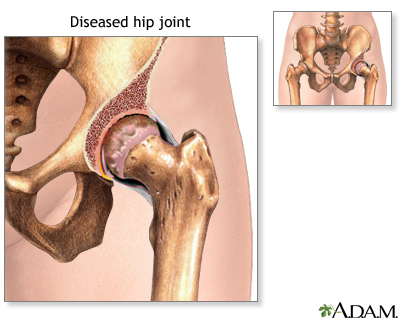Pregnancy SmartSiteTM
Hip arthroplasty; Total hip replacement; Hip hemiarthroplasty; Arthritis - hip replacement; Osteoarthritis - hip replacement DefinitionHip joint replacement is surgery to replace all or part of the hip joint with a man-made joint. The artificial joint is called a prosthesis. DescriptionYour hip joint is made up of 2 major parts. One or both parts may be replaced during surgery:
The new hip that replaces the old one is made up of these parts:
You will not feel any pain during surgery. You will have one of the following types of anesthesia:
After you receive anesthesia, your surgeon will make a surgical cut to open up your hip joint. This cut is often over the buttocks or the side of your hip. Then your surgeon will:
This surgery takes about 1 to 3 hours. Why the Procedure Is PerformedThe most common reason to have this surgery is to relieve arthritis. Severe arthritis pain can limit your activities. Most of the time, hip joint replacement is done in people age 60 and older. Many people who have this surgery are younger. Younger people who have a hip replaced may put extra stress on the artificial hip. That extra stress can cause it to wear out earlier than in older people. Part or all of the joint may need to be replaced again if that happens. Your health care provider may recommend a hip replacement for these problems:
Other reasons for replacing the hip joint are:
 Before the ProcedureAlways tell your provider what medicines you are taking, even medicine, supplements, or herbs you bought without a prescription. Your provider may also want you to lose weight prior to having surgery. During the 2 weeks before your surgery:
Practice using a cane, walker, crutches, or wheelchair correctly to:
On the day of your surgery:
Your surgeon will tell you when to arrive at the hospital. After the ProcedureYou will stay in the hospital for 1 to 3 days. During that time, you will recover from your anesthesia and from the surgery itself. You will be asked to start moving and walking as soon as the first day after surgery. Some people need a short stay in a rehabilitation center after they leave the hospital and before they go home. At a rehab center, you will learn how to safely do your daily activities on your own. Home health services are also available. Outlook (Prognosis)Hip replacement surgery results are very often excellent. Most or all of your pain and stiffness should go away. Some people may have problems with infection, loosening, or even dislocation of the new hip joint. Over time, the artificial hip joint can loosen. This can happen after as long as 15 to 20 years. You may need a second replacement. An infection can also occur. You should check with your surgeon periodically to ensure your hip is in good condition. Younger, more active people may wear out parts of their new hip. It may need to be replaced before the artificial hip loosens. ReferencesAmerican Academy of Orthopaedic Surgeons website. OrthoInfo. Treatment: total hip replacement. orthoinfo.aaos.org/en/treatment/total-hip-replacement/. Updated June 2020. Accessed August 23, 2023. Ferguson RJ, Palmer AJ, Taylor A, Porter ML, Malchau H, Glyn-Jones S. Hip replacement. Lancet. 2018;392(10158):1662-1671. PMID: 30496081 pubmed.ncbi.nlm.nih.gov/30496081/. Harkess JW, Crockarell JR. Arthroplasty of the hip. In: Azar FM, Beaty JH, eds. Campbell's Operative Orthopaedics. 14th ed. Philadelphia, PA: Elsevier; 2021:chap 3. Rizzo TD. Total hip replacement. In: Frontera WR, Silver JK, Rizzo TD Jr, eds. Essentials of Physical Medicine and Rehabilitation. 4th ed. Philadelphia, PA: Elsevier; 2019:chap 61. | |
| |
Review Date: 8/12/2023 Reviewed By: C. Benjamin Ma, MD, Professor, Chief, Sports Medicine and Shoulder Service, UCSF Department of Orthopaedic Surgery, San Francisco, CA. Also reviewed by David C. Dugdale, MD, Medical Director, Brenda Conaway, Editorial Director, and the A.D.A.M. Editorial team. The information provided herein should not be used during any medical emergency or for the diagnosis or treatment of any medical condition. A licensed medical professional should be consulted for diagnosis and treatment of any and all medical conditions. Links to other sites are provided for information only -- they do not constitute endorsements of those other sites. No warranty of any kind, either expressed or implied, is made as to the accuracy, reliability, timeliness, or correctness of any translations made by a third-party service of the information provided herein into any other language. © 1997- A.D.A.M., a business unit of Ebix, Inc. Any duplication or distribution of the information contained herein is strictly prohibited. | |

 Hip fracture
Hip fracture Osteoarthritis vs....
Osteoarthritis vs.... Diseased hip
Diseased hip
